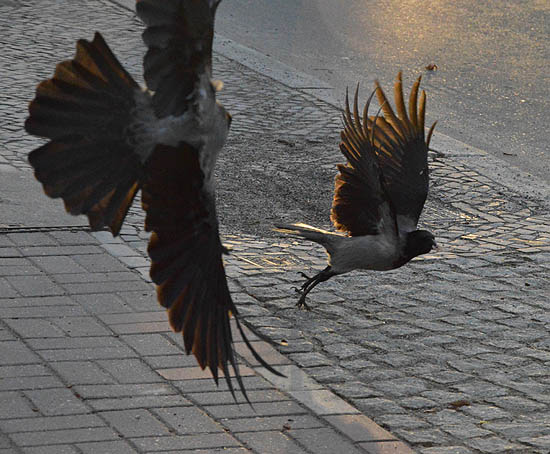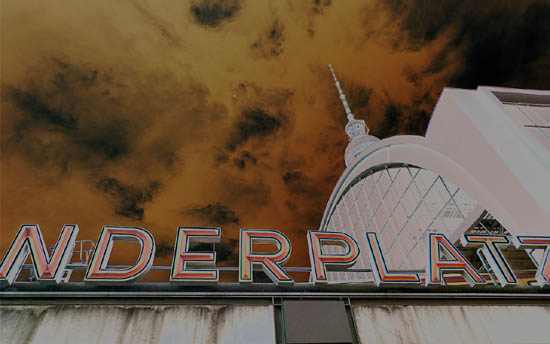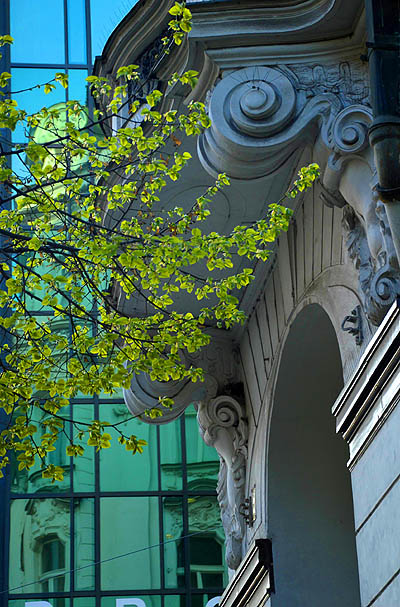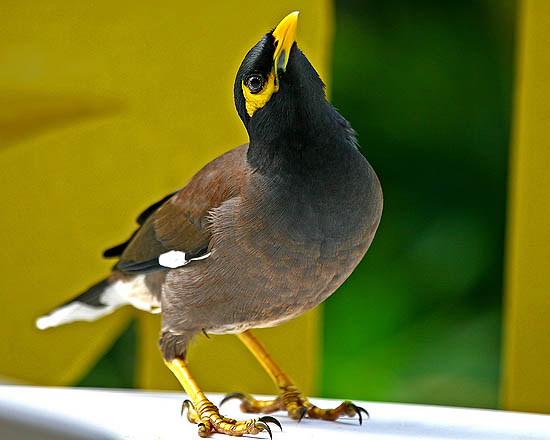
| This essay was first published in Czech on the web site His Voice: Magazine of Alternative Music, as part of the ongoing column “Field Notes.” |
In a recent filecast, I used the sound of steel against steel, and likened it to a strange bird call whose habitat is a blackened jungle, making use of the rousing noises of the city as an evocation this polar flip. I recall hearing this strange, ringing, piping sound while standing on the
 Alexanderplatz in Berlin as tram after tram rounded a tight corner. Steel wheels pressed against the polished rails, and with the full weight of a laden tram car bearing down, they emitted a bell-like resonant tone with a rich, throaty timbre. I closed my eyes and, unbidden, I pictured large prehistoric birds calling out to one another. The living montage of the city often has such a hallucinatory effect.
Alexanderplatz in Berlin as tram after tram rounded a tight corner. Steel wheels pressed against the polished rails, and with the full weight of a laden tram car bearing down, they emitted a bell-like resonant tone with a rich, throaty timbre. I closed my eyes and, unbidden, I pictured large prehistoric birds calling out to one another. The living montage of the city often has such a hallucinatory effect.
“56831 ocean of steel”, a sound composition by the author that makes use of the Alexanderplatz tram rail sounds described above
Hallucinatory effects are heightened in a city such as Prague, where the Gothic is introduced to the Baroque, and then both shake hands with the 20th century. Nude torsos buttress doorways and balconies, with writhing musculature straining under the weight of so much stone, and history. Carved faces grimace and scowl, while stalagmites of masonry rise to the clouds, topped with ersatz golden suns. A veritable menagerie of animals, real and fanciful, is easily observed, gracing the façades and portals. Bears, frogs, pigs, fishes, ostriches; and lions — lots of lions — stand in noble profiles surrounded by all manner of Baroque frippery. Brutal columns and diaphanous glass surfaces block sight lines, and reflect the reverse direction, modernism in an ongoing dialog with the antique. It can be dizzying.

 The trams on Karlovo náměstí (Charles Square) resound differently from those at Alexanderplatz; they are perhaps a bit sadder, more moaning than singing. Once I heard the cries of a wounded dog in the song of those rails. Combined with the the screams of the jays cavorting in the park and the low-hanging gray clouded sky, the effect was cinematic.
The trams on Karlovo náměstí (Charles Square) resound differently from those at Alexanderplatz; they are perhaps a bit sadder, more moaning than singing. Once I heard the cries of a wounded dog in the song of those rails. Combined with the the screams of the jays cavorting in the park and the low-hanging gray clouded sky, the effect was cinematic.Riding the dvaadvacítka (the no. 22 tram) one day, I had taken a seat on the left side of the car. My head was down, I was absorbed in what I was reading. I did not much notice the man seated in front of me, but my peripheral perceptions registered that he had white hair, and wore a dark blue jacket and brown trousers. At the next stop, there was another tram, headed in the opposite direction, on the set of rails next to me. People were still getting off and on. I saw, from the corner of my eye, a man with white hair, a dark blue jacket and brown trousers, taking a seat on the other tram car just as its doors were closing. In a split second, and without real thought, I formed the idea that the man who had been sitting in front of me had stepped down off my tram, crossed over the tracks and seated himself on the tram going in the opposite direction. Questions began to form. Had he forgotten something? Had he realized he’d been going in the wrong direction? Was he lost? From these questions, stories began to form to make sense of this behavior. But then, I looked up and saw that the white-haired blue-jacketed brown-trousered man was still still there, seated in front of me.
A woman stepped on with a pet carrier, and sat across from me. Suddenly I heard a radio playing. It was clearly a radio, but the broadcast was indistinct. Then it stopped. A series of mocking descending notes, a bit like derisive laughter, came from somewhere. I looked around, and could not find the source. A strange, tiny voice spoke language-like syllables, but no meaning was formed by them, and they seemed to be coming from a passenger whose lips were not moving. Then a burst of radio again. The woman with the pet carrier had an odd, telling look on her face, something between amusement and embarrassment.
I looked down and saw that there in the pet carrier, under the seat, with a little smirk on its yellow beak and a glint in its black beady eyes, was one of nature’s feathered ventriloquists, a mynah bird.


























































No hay comentarios:
Publicar un comentario